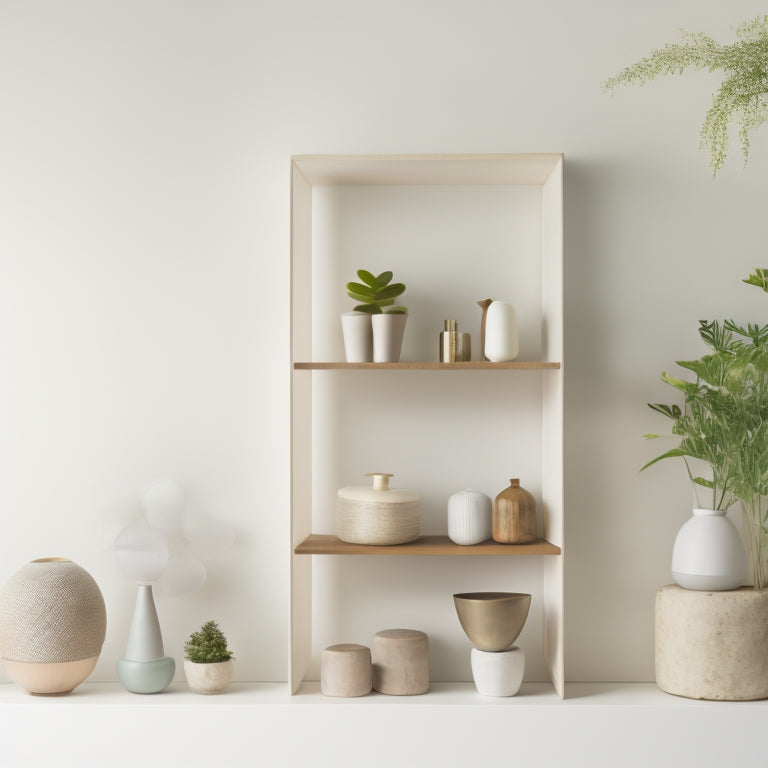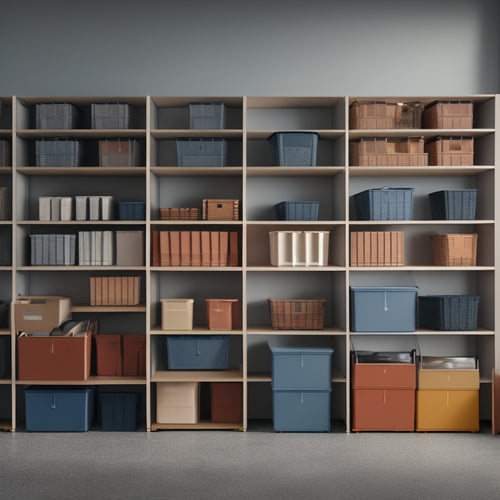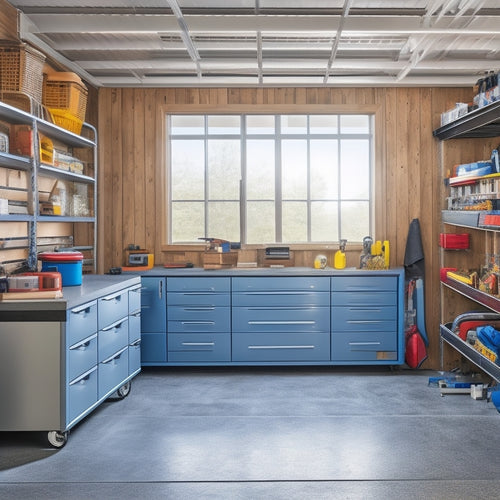
DIY Small Shelving Ideas for a Clutter-Free Home
Share
You can change your living space into a clutter-free haven by incorporating creative and space-saving DIY small shelving ideas that cater to your unique style and organizational needs. Start by prioritizing wall-mounted shelves to maintain open floor space and maximize vertical space. Consider adjustable and multi-purpose options, floor-to-ceiling shelves, and fold-down or sliding shelves for customized storage. Get creative with repurposed crates, DIY floating shelves, and budget-friendly materials like reclaimed wood, glass, or metal. By implementing these ideas, you'll be well on your way to a clutter-free home that reflects your personal style - and there's more to discover to make your space truly exceptional.
Key Takeaways
- Prioritize wall-mounted shelves to maintain open floor space and maximize vertical space for a clutter-free home.
- Implement adjustable shelving systems for customized storage needs and select multi-purpose furniture to reduce clutter.
- Repurpose crates and boxes into unique shelving units, emphasizing rustic charm while promoting sustainability and creativity.
- Place shelves between 30 and 60 inches off the floor for easy access, with an ideal shelf depth of 10-12 inches for effective storage.
- Focus on durability and stability with sturdy materials like solid wood or metal, and ensure shelves are securely attached to prevent accidents and damage.
Compact Shelving for Small Spaces
In tiny apartments, studios, and micro-units, every inch counts, and bulky shelving units can quickly clutter up the space. That's why you need compact shelving designs that prioritize functionality over aesthetics.
Look for wall-mounted shelves that leave floor space open for other essentials. Consider using stackable crates or baskets to store items like linens, books, or kitchen utensils. These multifunctional storage solutions can be easily rearranged to suit your changing needs.
When choosing compact shelving, prioritize durability and stability to guarantee your safety. Opt for sturdy materials like solid wood or metal that can support the weight of your belongings.
Avoid wobbly shelves that can topple over, causing accidents or damage to your possessions. Instead, invest in cleverly designed shelves with built-in stops or safety features that prevent items from slipping off.
Maximizing Corner Storage Potential
When you're working with small spaces, every inch counts, and corners often get wasted.
You can reclaim this real estate with corner shelving units specifically designed to fit snugly into these tight spaces.
Corner Shelving Units
Maximizing the often-wasted space in corners is a clever way to enhance your storage capacity, and corner shelving units are the perfect solution. By installing a corner shelving unit, you'll create a functional and visually appealing space that keeps clutter at bay.
When choosing a corner shelf, consider the materials that fit your style and needs. Glass corner shelves add a touch of elegance, while wooden corner shelves bring warmth and coziness. You can also opt for metal or MDF corner shelves for a more modern look.
Corner shelf styles range from minimalist to ornate, so you're sure to find one that complements your home decor. Remember to measure your corner space carefully before selecting a shelving unit to guarantee a perfect fit.
You can also customize your corner shelf to fit your specific needs, such as adding baskets or bins for extra storage. With a corner shelving unit, you'll be able to store items like books, decorative pieces, and kitchen utensils, keeping them organized and within reach.
Space-Saving Design Tips
You've optimized your corner space with a shelving unit, now it's time to make the most of it. To maximize your corner storage potential, consider these space-saving design tips:
-
Choose multi-purpose furniture: Select shelving units that double as desks, tables, or benches to reduce clutter and increase functionality.
-
Opt for minimalist organization: Keep your shelves uncluttered by storing items in labeled baskets or bins, and leave some space between them for a visually appealing display.
-
Utilize vertical space: Install floor-to-ceiling shelves or storage units to make the most of your wall space and keep frequently used items within easy reach.
-
Select adjustable shelving: Invest in shelving units with adjustable shelves to accommodate items of varying sizes and guarantee efficient storage.
-
Consider a carousel: Install a rotating carousel in a corner to easily access items in hard-to-reach areas, such as cleaning supplies or kitchen utensils.
Creative Use of Wall Space
You'll be amazed at how much storage you can squeeze out of your walls by maximizing vertical space, strategically placing shelves to optimize functionality, and incorporating decorative ledge options that add visual interest.
Maximizing Vertical Space
Frequently, the most underutilized area in a room is the wall space, which can be a game-changing factor when it comes to storage and organization.
By maximizing your vertical space, you'll be amazed at how much clutter you can eliminate from your floors and surfaces.
Take advantage of wall mounted racks to store items like bicycles, tools, or even pots and pans. You can also create a vertical garden, adding a touch of greenery to your room while keeping the floor clear.
Here are some more ideas to get you started:
- Install floating shelves to display decorative items or store books and binders
- Use wall-mounted hooks to hang jackets, hats, or bags
- Invest in a pegboard to organize tools, accessories, or kitchen utensils
- Create a storage nook for linens, cleaning supplies, or office materials
- Hang a foldable drying rack for laundry or a planter for herbs or succulents
Optimal Shelf Placement
Beyond the obvious benefits of maximizing vertical space, strategically placing shelves can make all the difference in creating a functional and aesthetically pleasing room.
When deciding on shelf placement, consider the activities that will take place in the room and the items that will be stored. For example, if you're planning a home office, place shelves at a comfortable height for easy access to frequently used office supplies.
In general, shelves should be placed between 30 and 60 inches off the floor, allowing you to easily reach items without straining.
Shelf depth is also essential, as it determines how much you can store and how easily you can access items. A shelf depth of 10-12 inches is ideal for most rooms, providing ample storage without overwhelming the space.
Additionally, consider the weight capacity of your shelves and the items you plan to store to guarantee safety and stability.
Decorative Ledge Options
By incorporating functional shelving, you've already taken a significant step towards creating a clutter-free space.
Now, it's time to think about the aesthetic appeal of your walls. Decorative ledge options can enhance your shelf styling and add a touch of personality to your rooms.
Consider the following ideas to take your ledge decor to the next level:
-
Floating shelves: Create a sense of minimalism by attaching floating shelves to your walls, perfect for displaying decorative items or books.
-
Recessed ledges: Build recessed ledges into your walls for a sleek, modern look that adds depth to your space.
-
Layered shelves: Combine multiple shelves of varying depths to create a visually interesting display area.
-
Decorative brackets: Add ornate brackets to your shelves for a touch of elegance and sophistication.
-
Magnetic ledges: Install magnetic ledges for a unique and functional way to display metal decorative items or kitchen utensils.
DIY Floating Shelf Ideas
With a few simple tools and some creativity, you can create stunning DIY floating shelves that add a touch of elegance to any room.
To get started, choose the right floating shelf materials that fit your style and budget. You can opt for reclaimed wood, glass, or metal shelves, depending on the look you want to achieve.
Next, select decorative shelf brackets that complement your shelf material. These brackets come in various designs, from modern and sleek to rustic and ornate. Be certain to choose brackets that can hold the weight of your shelf and the items you plan to display.
When assembling your floating shelf, follow the manufacturer's instructions and take necessary safety precautions. Use a level to verify your shelf is straight, and drill pilot holes to avoid splitting the wall or shelf material.
With a little patience and attention to detail, you can create a beautiful DIY floating shelf that adds a touch of sophistication to your space.
Repurposed Crates and Boxes
Changing repurposed crates and boxes into unique shelving units is a fantastic way to add a touch of rustic charm to your space while reducing waste.
You can find crates and boxes at thrift stores, garage sales, or even in your own garage. With a little creativity, you can convert them into functional and stylish shelving units that add character to your home.
Here are some ideas to get you started:
-
Stack and secure: Stack crates of varying sizes to create a unique shelving unit. Secure them with screws or nails to guarantee stability.
-
Add a back panel: Attach a back panel to a crate to create a more polished look and provide additional support.
-
Paint and stencil: Paint and stencil crates to match your home decor and add a personal touch.
-
Add casters: Attach casters to crates to create a mobile shelving unit that's easy to move around.
-
Combine with other materials: Combine crates with other materials like wood, metal, or fabric to create a truly unique shelving unit.
Hidden Storage Solutions
You've added rustic charm to your space with repurposed crates and boxes, but now it's time to think about hiding the clutter. Hidden storage solutions are a great way to keep your belongings out of sight while maintaining a sense of organization and tidiness.
| Hidden Storage Ideas | Description |
|---|---|
| Secret Drawers | Add a false bottom or back to a drawer to create a hidden compartment |
| Hidden Compartments | Install a sliding panel or hidden door to conceal storage areas |
| Decorative Containers | Use ornate boxes or vases to store small items like jewelry or keys |
| Behind-the-Mirror Storage | Attach a cabinet or shelf to the back of a mirror for hidden storage |
| Ottoman Storage | Choose an ottoman with a hidden compartment for storing linens or out-of-season clothes |
These hidden storage solutions will help you keep your clutter under wraps, creating a more peaceful and organized living space. By incorporating these ideas into your DIY shelving project, you'll be able to maintain a sense of calm and serenity in your home.
Space-Saving Shelf Designs
Optimize your DIY shelving project by incorporating space-saving shelf designs that maximize storage capacity while minimizing floor space. This is particularly important in small homes or apartments where every inch counts.
By choosing the right design, you can create a clutter-free space that's both functional and aesthetically pleasing.
Some space-saving shelf design ideas to evaluate include:
- Adjustable shelving systems that allow you to customize the height and depth of your shelves to fit your specific storage needs
- Minimalistic shelf designs that use clean lines and simple shapes to create a sense of openness and airiness
- Fold-down shelves that can be easily tucked away when not in use
- Sliding shelves that provide easy access to items in the back
- Corner shelves that make the most of often-wasted space
Utilizing Vertical Space Efficiently
By incorporating space-saving shelf designs, you've already taken a significant step towards maximizing your storage capacity. However, to truly optimize your space, you need to think vertically. Utilizing vertical space efficiently is key to creating a clutter-free home.
| Shelf Materials | Vertical Garden Ideas | Safety Considerations |
|---|---|---|
| Reclaimed wood | Wall-mounted planters | Secure shelves to walls |
| Metal | Hanging baskets | Use sturdy ladder |
| Glass | Trellis systems | Avoid overloading shelves |
| Wooden crates | Vertical herb gardens | Soften corners with padding |
| PVC pipes | Living walls | Install shelves at comfortable heights |
When designing your vertical space, consider the materials you use for your shelves. Reclaimed wood, metal, glass, wooden crates, and PVC pipes are all great options. You can also incorporate vertical gardens, such as wall-mounted planters, hanging baskets, or trellis systems, to bring some greenery into your home. Remember to prioritize safety by securing your shelves to walls, using sturdy ladders, and avoiding overloading your shelves. With a little creativity, you can create a functional and beautiful vertical space that enhances your home's storage capacity and aesthetic appeal.
Budget-Friendly Shelving Options
Designing a functional and stylish shelving system doesn't have to break the bank. You can create a clutter-free home without sacrificing your wallet.
With a little creativity, you can build budget-friendly shelving options that are both functional and aesthetically pleasing.
Here are some affordable materials and simple constructions to contemplate:
-
Repurposed crates: Use wooden crates to create a rustic shelving unit that adds character to your room.
-
IKEA hacks: Upcycle IKEA shelves by adding a fresh coat of paint or new hardware to give them a personalized touch.
-
PVC pipes: Employ PVC pipes to create a simple and affordable shelving system that's easy to assemble.
-
Reclaimed wood: Get creative with reclaimed wood to build a one-of-a-kind shelving unit that's both eco-friendly and budget-friendly.
-
Floating shelves: Opt for floating shelves made from affordable materials like MDF or plywood to create a sleek and modern look.
Customizing Shelving for Style
Several clever tweaks can enhance your shelving unit from functional to fabulous. You can start by experimenting with different shelf materials, such as reclaimed wood, glass, or metal, to add texture and visual interest.
Consider mixing and matching materials to create a unique, eclectic look.
Next, focus on styling techniques to make your shelves a design focal point. Try grouping decorative objects, like vases or sculptures, in odd numbers to create a visually appealing arrangement. You can also add some greenery, like potted plants or a living wall, to bring in a touch of nature.
Don't be afraid to get creative with your shelf styling – the key is to have fun and experiment until you find a look that reflects your personal style.
Remember to keep safety in mind when customizing your shelving unit. Ascertain that your shelves are securely attached to the wall and can hold the weight of the items you plan to display.
With a little creativity and attention to detail, you can turn your shelving unit into a stunning design element that adds personality to your space.
Frequently Asked Questions
How Do I Secure Shelves to Prevent Them From Tipping Over?
When you're building shelves, you'll want to guarantee they're stable; you're securing them to prevent tipping. Choose sturdy shelf materials, like solid wood or metal, and use reliable securing methods, such as wall anchors or anti-tip brackets, to keep your shelves firmly in place.
Can I Use DIY Shelving in a Rented Apartment or House?
You can use DIY shelving in a rented space, but consider temporary solutions that won't damage walls or floors, and always check your rental restrictions before installing anything to avoid potential penalties or lease issues.
Are DIY Shelves Suitable for Holding Heavy Objects or Books?
When building DIY shelves, you'll want to make certain they can hold heavy objects or books, so consider the shelf's weight capacity and the strength of materials used, like solid wood or metal, to avoid collapse and guarantee safe storage.
How Do I Attach Shelves to Plaster or Drywall Without Damaging Them?
When attaching shelves to plaster or drywall, you'll want to use shelf mounting techniques that guarantee stability and safety. Opt for plaster anchors, which securely hold screws in place, preventing damage to the wall and assuring a sturdy shelf installation.
Can I Use Reclaimed or Second-Hand Materials for DIY Shelving?
You can definitely use reclaimed or second-hand materials for DIY shelving, embracing creative sourcing to reduce waste. These materials often offer unique character and eco-friendly benefits, like reduced carbon footprint and preserved natural resources, while adding a touch of personality to your space.
Conclusion
You've made it to the finale of your DIY small shelving expedition! With these creative ideas, you're well on your way to a clutter-free home. Did you know that the average American spends around 1.5 hours a day searching for misplaced items? By implementing these space-saving shelving solutions, you'll not only free up time but also reduce stress and increase productivity. So, get building, and start enjoying your newly organized oasis!
Related Posts
-

Choosing the Right Stacked Storage Bins
When choosing the right stacked storage bins, you'll want to evaluate your storage needs, considering inventory types...
-

Best Screw Storage Bins for Organizing Your Toolbox
You need a reliable screw storage system to maximize your productivity and efficiency, and that's exactly what the ri...
-

Top Rolling Tool Box Drawers for Maximum Storage
When it comes to maximizing storage with rolling tool box drawers, you need a solution that combines durability, cust...


